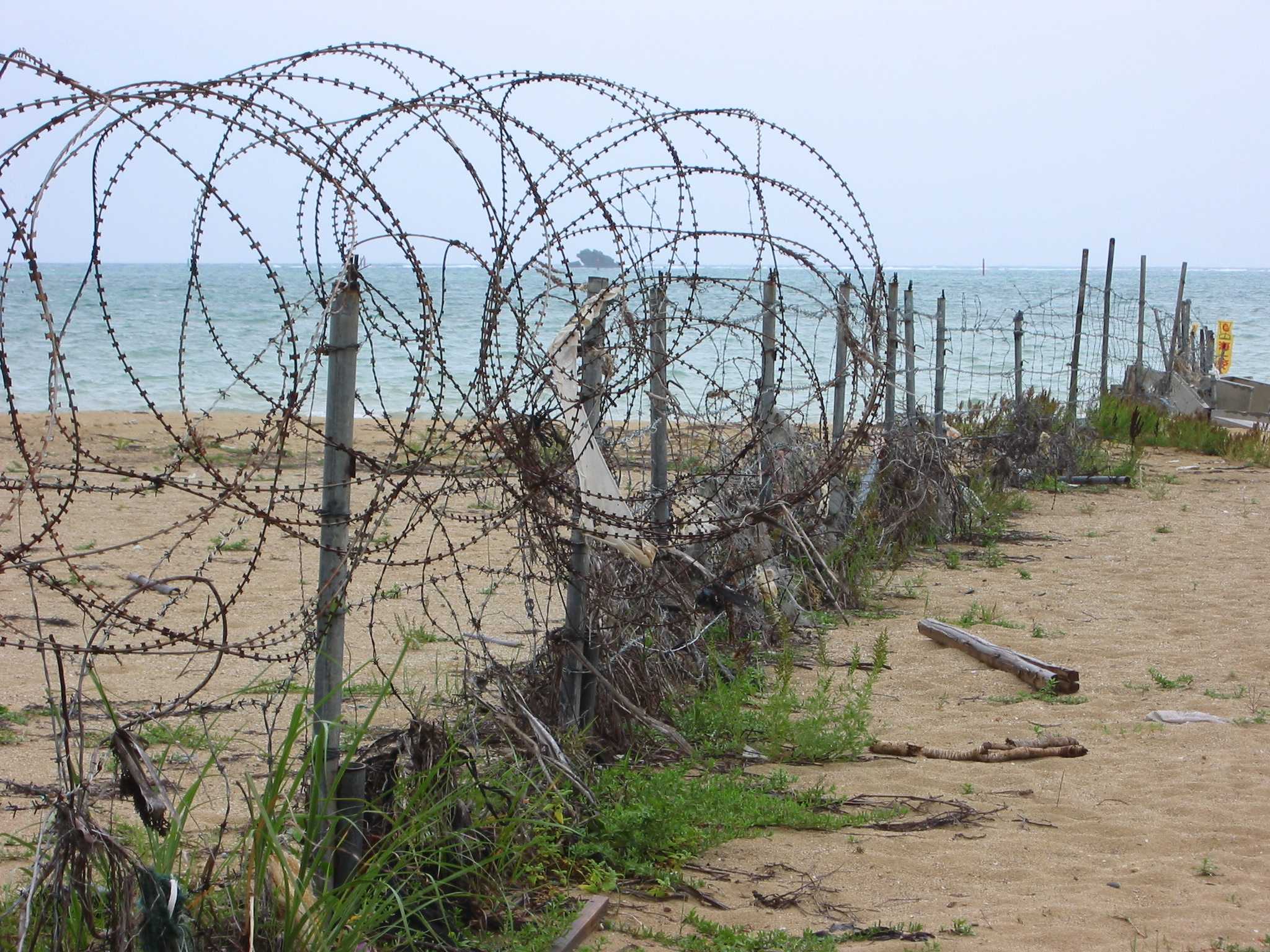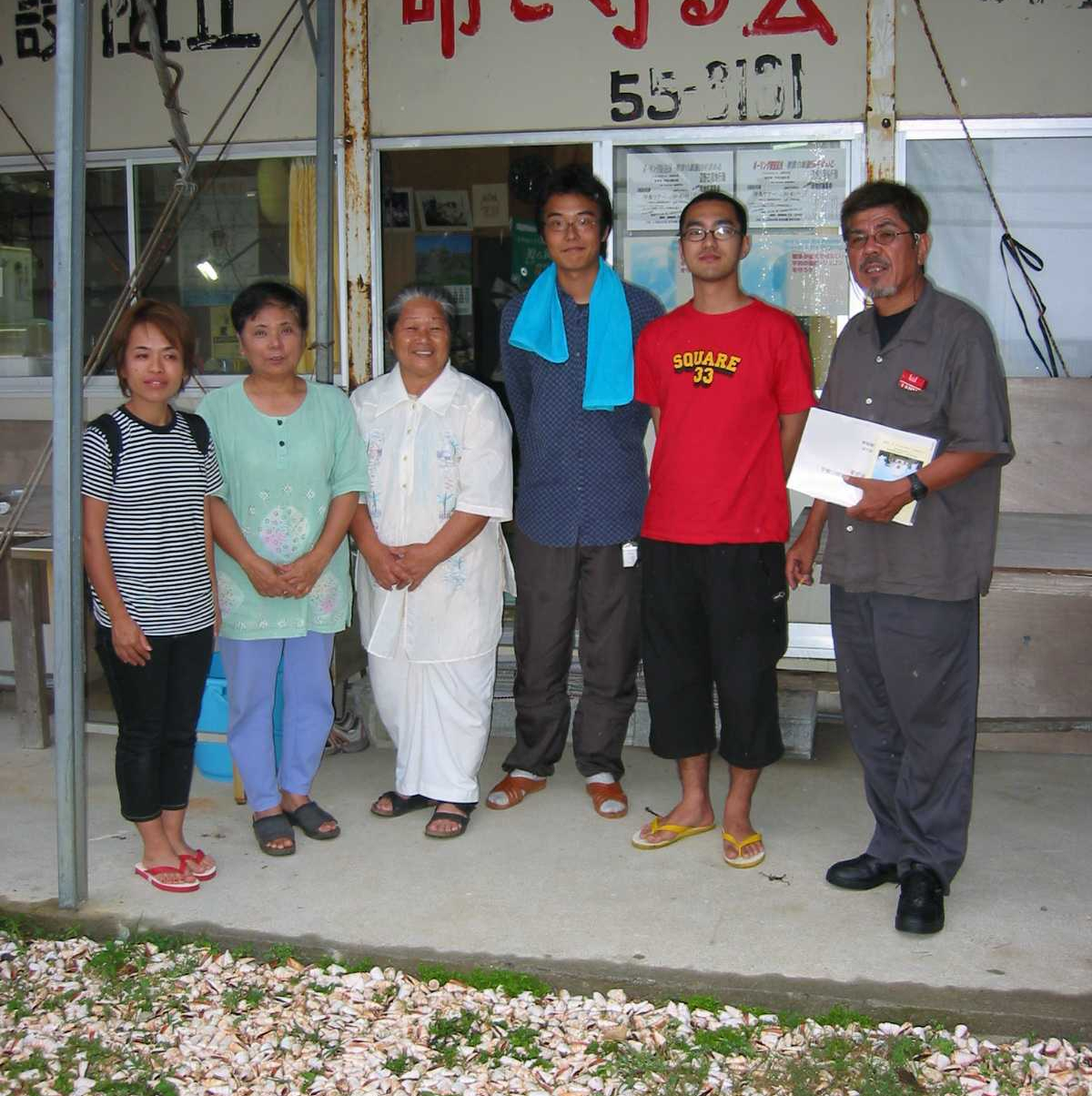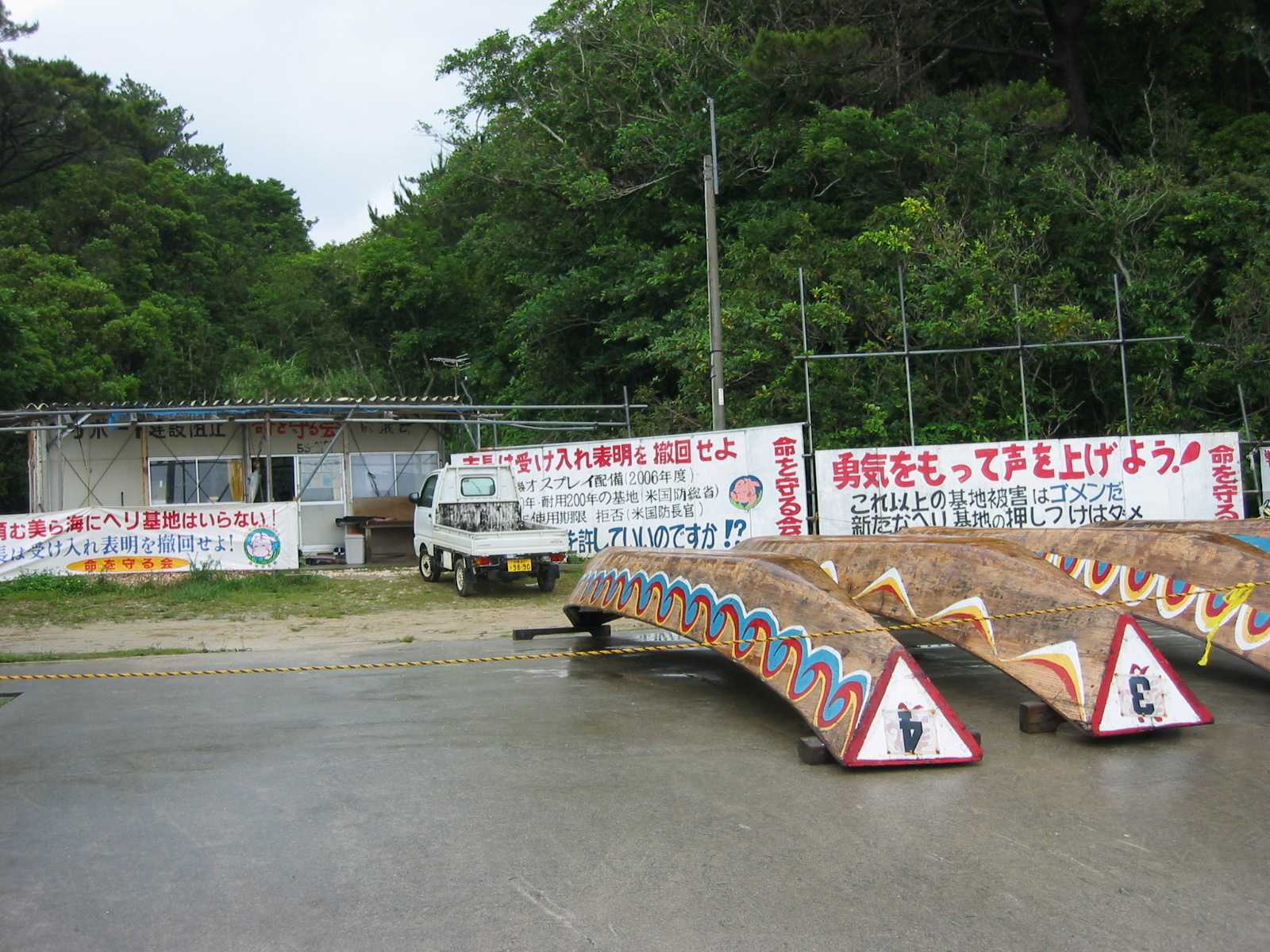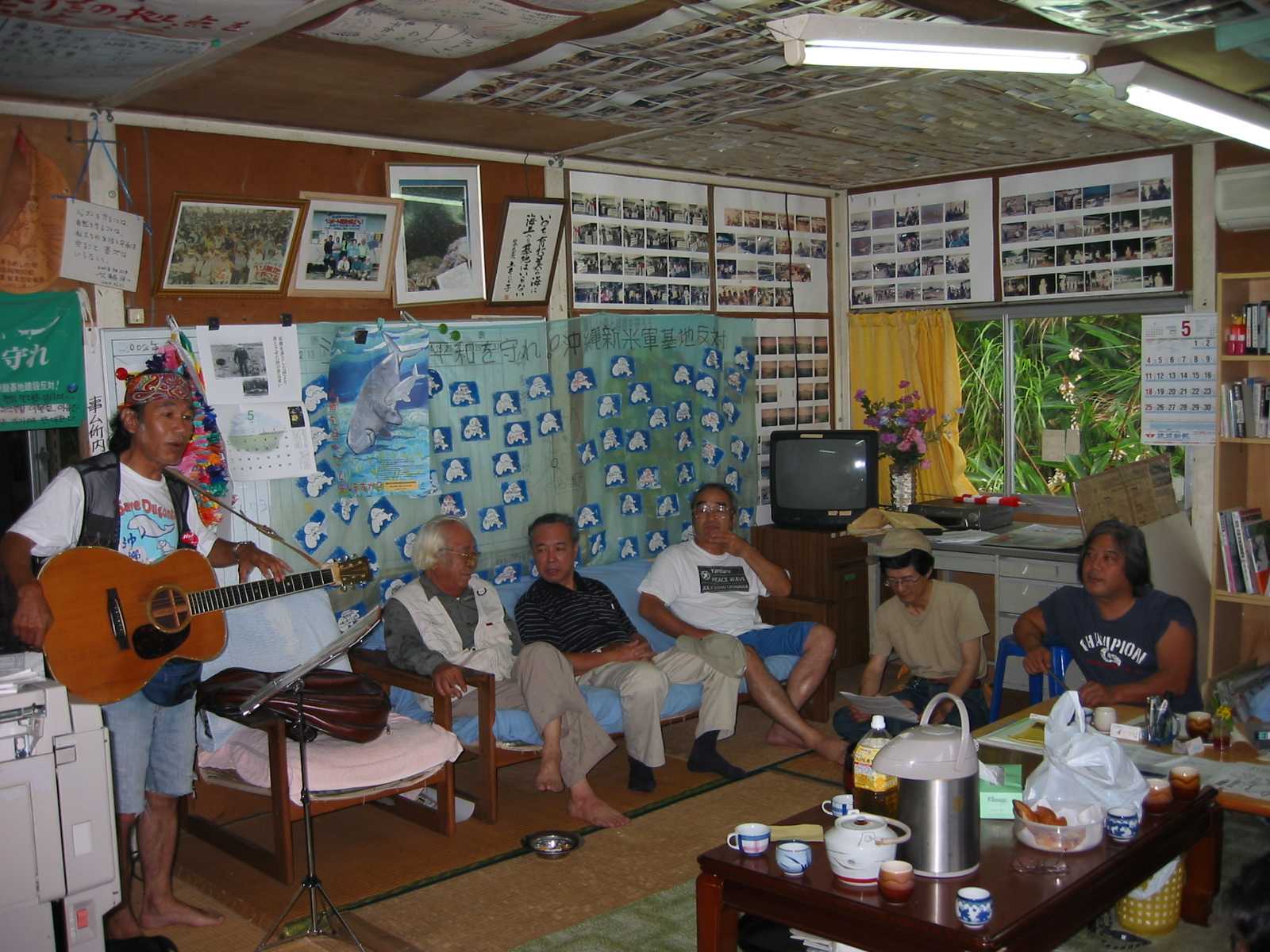“ The USA wants to build a new military base on a coral reef at the southern tip of Japan.” It is hard to believe this newsnotice. What kind of ghost is this from a past when nuclear tests systematically demolished coral atolls of the Pacific Ocean: Bikini-islands, Marshall islands, Enewetok and Moruroa?
By Per-Erik Schulze, Marine biologist, FoE Norway. At Okinawa, Japan.

In 2003 and then again in 2016 i visited Okinawa, met activists, scientists, divers, locals and US Marines to figure out how anyone would think about trading a healthy coral reef for a military base. Here is article 1 out of 2. This one published in Norwegian Environmental Magazine Natur & Miljø back in 2004, but here for the first time in English translation. All photos are mine if not otherwise mentioned. Read also the 2016 report: At the brink of US Military Oceanocide.
Coral reefs and seagrass lagoons are the “rainforests of the oceans”, with an immense biodiversity. Coral reefs are threatened or destroyed all around the Earth, but outside the southern tip of Japan you can still find a rare treasure of pristine reefs; Okinawa.

Welcome to Japan’s number one holiday destination – 160 subtropical, green islands, spread out in a hypnotizing blue ocean. Geological survey workers are preparing the ground for the proposed US military base at Okinawa main island, where a fringing coral reef area equalling 304 soccer fields will soon be covered with rocks and asphalt. Okinawa’s 1.3 million inhabitants, and international nature conservation groups are very upset. The Japanese central government is formally in charge, but no one I talked to at Okinawa hesitated in pointing out who is really behind the project.
Years and years of occupation
USA’s heavy military presence in Okinawa is due to big politics, and has a tragic history. “An Okinawa of suffering” is even established as a term in our language. USA lost 15 000 soldiers, Japan 110.000 in their last stand at the very end of the second world war. The people of Okinawa calls those days “the rain of steel”. 140.000 Okinawans were killed. Paradise was lost for the islanders known for their relaxed lifestyle and high expected age of living.
USA won the war, and occupied the islands. The inhabitants were forced away from their properties and land, and moved to ghettoes, while the USA built military airfields, weapon depots and half a hundred military settlements in what used to be villages. The USA saw Okinawa as a key military-strategic asset, isolated, but still just an afternoon’s flight from most Asian countries.

Modern times for Okinawa ment nightclubs, whorehouses, American dollars and the humming of US warplanes taking off for Korea and Vietnam. In 1972 the islands were transferred back to Japan, but USA has still today more than 25.000 soldiers stationed there, occupying 20 % (120 km2) of Okinawa main island, and several sea areas and smaller islands.
Enough is enough
The Okinawan authorities and citizens have repeatedly made it very clear that this situation is unbearable, and appealed for a US base reduction. They link a string of road accidents, criminality and pollution to the US servicemen. Helicopter warships do emergency landings in school playgrounds. Shooting and bombing ranges have been left without clean up. Traditional harvest of nature products from the beach and forest is made impossible because US occupies the most valuable areas. In 1995 Okinawa once again exploded in mass demonstrations against the US presence, after a rape of a 12 year old Okinawan schoolgirl. Three US servicemen was together behind the abuse.
The protest marches did not rest before USA and the central Japanese government in 1996 presented a plan on how USA should, piece by piece, remove their forces.
US digging in
When visiting Okinawa in 2000, the then US president Bill Clinton stated in a speech at the peace monument that whatever the US are doing at Okinawa in the future it shall not repeat the mistakes from the past. – We will keep all our commitments, and do what we can to reduce our footprint on this island. Japanese Prime Minister Junichiro Koizumi and U.S. President George W. Bush recently said to once again “agree on the need to reduce the U.S. military presence in Okinawa.” What the Okinawans instead see that the Americans helped by the Japanese central government just now build new facilities.

The most controversial project is the 2500-by-730 meter military base on top of a coral reef and dugong feeding ground at the Okinawa main island. In the place called Henoko on the northeastern part of the island, at the fringing reef outside the US Marines’ Camp Schwab, the US is asking for this new facility to be constructed. The setting is close to the Northern Training Range, the only remaining jungle-training center for the Americans, after having left Panama and Philippines. The new base was given a go from the Japanese Government in 2002, with a 10 years preparation and construction period due to its enormous proportions. The purpose of the base is to provide relocation of US Marines’ helicopter units and fighter jets, potentially provide a base for the future deployment of Osprey helicopter planes, and to provide a facility for transporting ammunitions and equipment smoothly between sea, air and land. In bunkers close by, the US Forces have stored ammunitions for a potential future Korean or Pacific war.
In the treaties Japan had to sign after the war it said that USA would take care of Japanese military security. Japan on their hand should provide the necessary land and facilities for the US forces.

The man and the sea
–If new US military bases are important to Japanese security, why don’t build them in Tokyo Bay instead of here at Henoko, says Mr. Takuma Higashionna.
He lives in the fishing village nearby. Higashionna used to be construction worker. He quit in protest when his company got involved in building new US facilities. Trading his hardcap for a kayak, he is instead working as tour guide, teaching the importance of nature and sea life. He brings school children from all over Japan out in what is still the marine paradise of Henoko bay.

The bay has the bluest ocean you can think of, and is surrounded by the best beaches on the island. Protecting the bay against the Pacific swell is a kilometer long fringing reef, that has developed its unique shape and fauna over thousands of years. A warm Pacific current maintains the tropical marine life here at the northernmost outpost of the world’s coral reefs. Many of the animals living here exist only here.
The Henoko reef has, as other fringing reefs around the world, the last years struggled with episodes ov overheated surface water. This phenomena is believed to be a results of global warming, and kills some of the corals in coral bleaching events. There has also been epidemies of coral-eating crown-of-thorn starfish. But as part of the natural cycle, the reef is on the recovery. It has not yet seen any such general ecological collapse as has for example reefs at Jamaica or the Indian ocean.

In an Octopus’ garden
And luckily, for most of the reef organisms at Henoko, it doesn’t really matter if the coral cover is 20 or 70% as long as there are still places to hide, algae to eat and a current from the south that can bring coral recruits from time to time.
Taking a dive you see corals and a dense variety of colorful reef fish and other sea creatures. Here you can hear the parrot fishes munch encrusting algae or see them sleep in their cocoons, see the damselfish garden their lawns or fan their eggs, or watch octopuses change color like a kaleidoscope. Large sea turtles mates and nests in the bay. And even more exciting to visitors and locals, the bay has underwater fields of short sea grasses that are the favorite food of dugongs (sea cows).
Dugongs say “no”
The presence of dugongs at Henoko is not an unfounded fisherman’s tale simply set out to stop the new US base.
-My grandparents generation were eating dugongs for religious purposes, so these animals were definitively around, says Higashionna. For many years after the war though these large marine mammals were forgotten, except for occasional dead specimens drifting ashore with their bodies deformed by fishing nets or boat propellers. The one washed ashore in 1995 was said to be the very last one.
It happened to be a weather survey conducted as preparation for the new US base at Henoko that some time later reported, hidden as a single sentence in the back of the document, that a dugong was spotted just off Henoko. –From that on I got completely charmed by dugongs, tells Higashionna.
Encouraged by the dugong report, in 1998 a Nippon TV cameraman at his own initiative chartered a helicopter for three days going dugong spotting, at the risk of loosing his job if he returned to his boss empty handed with a big bill. The second day the gambling paid off, and the first Japanese dugong ever filmed alive soon become a TV star.


Dugongs, alone or in small groups, have later been spotted around Henoko by a number of credible sources. The Japanese population is estimated at below 50 individuals, maybe only ten. Okinawa is their home.
Everyone say “no”
Save Mermaid Dugong against US bases, says the large protest banners posted along the main roads of Henoko and Nago. The protest movement has support from a majority of the locals, as shown in a December 1997 referendum among the 55.000 citizens of the district. In addition 19.000 persons from all over the island has signed a petition to the US Embassy and the Japanese Government to stop the Henoko plan. Public opinion polls have shown that as much as 78% of Okinawans favor removing the US Marines air base from the island completely. But the protests are not limited to within the Okinawan territorial waters.
Kaori Sunagawa is coordinator in Okinawa Environmental Network (OEN), and has experienced a large national and international support in the Henoko case. The network was founded in 1996 in cooperation with professor Jun Ui, famous in Japan for his studies of industrial pollution such as Minamata. OEN is largely a response to the variety of environmental problems caused by the U.S bases at Okinawa. OEN was an important player at the Okinawa summit in 2000, and in March this year arranged at Okinawa University the first international symposium on military related environmental problems. Sunagawa says there has been a wave of international resistance against US environmental abuse at all overseas bases, and this movement is now coordinating their protests.

She says a wide range of internationally respected non governmental organizations are now demanding stop in the planned destruction of a coral reef and dugong habitat at Henoko. The Japan environment lawyers federation, World Wildlife Fund, United Nations Environmental Program, the World Conservation Union (IUCN), and famous scientists on reefs, sea animals, sea grass and dugong are among the protesters lining up to complain at the US and Japanese Government. As we speak, Sunaguwa gets the phone call from a journalist in Tokyo that Okinawa’s nature is nominated by the Environmental Ministry for a UNESCO World Heritage listing. But Sunagawa doesn’t think this will save the reef.
Secret construction commitee
-Our main problem is limited access to information about the military plans, Sunagawa says. Unlike in Europe and in US where large construction projects only can be allowed after public participation and an environmental impact assessment, the joint US-Japanese committee making decisions on the Henoko-base is keeping all important information classified, she says. – We don’t even know ho is in this committe. All we know is that the Japanese authorities now has got the task to lead the construction process.
A year ago her organization brought a complaint to the Japanese Defense Facility Office at Okinawa that geological surveys were started at the Henoko site before any environmental assessments of the project are made. This is a breach of Japanese law. In addition OEN worries that the part of the survey that includes ramming down more than 60 large core sample devices from drilling towers will severely disturb dugong and other life at the site. The complaint was presented in a meeting. The authority representatives abruptly left the meeting as soon as the controversial issue was raised, and denied to talk more with the environmental NGO’s.
Who can defend the Henoko-plan?
The US Forces neither have any public comments to give about their planned new base. This despite that the US Marines already today are enjoying Henoko Bay from their amphibian vehicles, rubber dinghies and recreation beaches at Camp Schwab.
–This is now a project in the hands of Japanese defense authorities, and we can not comment on the issue, says media relations’ officer Chris Perrine at the US Marines Okinawa Head Office.

The 45 people strong Environmental Office of The US Marines at Okinawa neither have any comments on the project. The office has had awarded successes the latest years in mitigating environmental impacts from the bases, such as red soil runoff, toxic spills and loss of biodiversity. The office claims that environmental protection now enjoys highest priority, and that their. But their commanding power suddenly stops halt when it comes to giving advice concerning the weird idea of building a base on top of a coral reef. Joe Vogel, one of the veterans in the Environmental Office comments. – We have been told to stay out of this project. Besides, I think US just gives the technical requirements, the location was really a Japanese idea, he ads.

Other persons on the island seems to be better informed about the US intentions and role in the project, and want to talk. Yoshikazu Makishi is architect of profession, and a successful one. He designed Okinawa University, and several other major public buildings on the island. He is just the right person to dig up and understand hidden documents and master plans regarding the US bases. This is the type of US documents stamped “ Secret. Not releasable to foreign nationals. Excluded from the general declassification schedule.”

In May 2001 Makishi disclosed in an article in the magazine Syukan Kin’yobi (Weekly Friday) what he calls the US conspiracy about Henoko. A look into his background documents leaves no doubt that a new base at Henoko has been a long time Pentagon plan. Already in 1966 there existed detailed US Pacific Command construction plans for a landfill and base at Henoko, and in 1972 the US diplomats both in Washington and on the island worked on a strategic plan on how to get the Japanese Government to pay the extensive construction expenses for such future facilities.
-In 1995, camouflaged as a friendly response to the overwhelming demonstrations that demanded the bases closed after the infamous rape incident, the US Defense authorities finally got the Japanese support to “relocate” an outdated Futenma Airport to a bright new facility at Henoko, says Makishi. The construction plans for a US base on top of the coral reef and lagoon at Henoko largely replicates the 1966 plan. Planning and construction work are now to be done and paid by the Japanese Defense Facility. No more hassle for the US, and no answering of tricky questions about environmental liability.
– They even managed to create some local support for the project, because it constitutes a trillion yen gold rush for construction companies, but the majority of Okinawans think it is a horrible idea, Makishi explains. Having a look at one of many non-public documents of “Operational Requirements” from the US Department of Defense soon convinces you that the US technical requirements are many for the Henoko project, while the environmental requirements are non-existing.
Plan-documents from the Japanese Defense Facility, who are now in charge of the construction project, does not leave any more hope for the coral reefs and dugongs. Information about environmental qualities such as coral and sea grass cover at the construction site is systematically withheld from the maps. Japanese Henoko officials, according to the US military think-tank Global Security, have said that the dugongs never really were a consideration in the decision process. In this perspective the promised Japanese Defense Facility Office’s Environmental Impact Assessment of the Henoko project seems like a farce to the local islanders.
The locals promise tough resistance and large protests to the construction project if it progresses. More than 50 canoes are standby, but it will have to be more to room the thousands of people that are expected to join in from all over the island and overseas. It seems pretty clear that the US base at Henoko is an US liability even before the first rock is dropped into the ocean of dugongs and coral reefs.


Learn more about the fight to save Henoko and Oura Bay:
“Henoko, The Sit-in on The Sea” Documentary film featuring Mr Higashionna, with English subtitles, about the early stages of the protest, against the geological surveys for the construction project in the bay. Part 1 Part 2
Underwater video gallery from Oura Bay by local Diving Team Snack Snufkin
The blog of Henoko Blue, the canoe team protecting Oura Bay.
Petition by Friends of The Earth Japan, the latest of many:
STOP DUMPING in the sea of Henoko, Okinawa